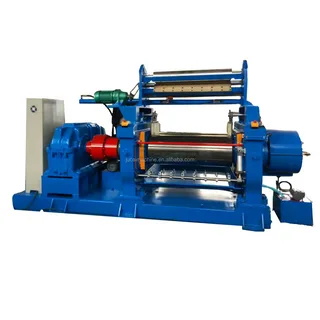Difference between Rubber Mixing Machine and Vulcanizing Machine
Definition and Function
Rubber Mixing Machine: A Rubber Mixer is a device used to evenly mix various rubber raw materials and additives (such as fillers, accelerators, antioxidants, etc.). Its main purpose is to ensure that each component is fully integrated for subsequent processing and molding. Rubber mixers are usually used in the early stages of rubber production and are key equipment for manufacturing high-performance rubber products.

Vulcanizing Machine: A vulcanizing machine is used to vulcanize mixed rubber products. Vulcanization is to form a three-dimensional cross-linked structure by heating rubber and reacting with a vulcanizing agent, thereby significantly improving the strength, elasticity, wear resistance and weather resistance of the rubber. Vulcanizing machines ensure the reliability and stability of the final product during use and are widely used in the production of tires, seals and other products.

Working Principle
Rubber Mixing Machine:
Principle: Rubber mixers usually adopt internal mixing or open mixing processes. The internal mixer has two screws that rotate against each other, which can fully mix the rubber material and additives at high temperatures. The open milling process uses the shear force between two rollers to stretch and mix the rubber raw materials. By adjusting the temperature and mixing time, the characteristics of the final mixture can be controlled to ensure that the physical and chemical properties meet the requirements.
Vulcanizing Machine:
Principle: The Vulcanizer heats the rubber product in a closed mold, usually under a certain pressure. The heat causes the vulcanizing agent (such as sulfur) to react with the rubber molecules to form a cross-linked structure. This process usually requires a specific time and temperature to ensure complete vulcanization. Different vulcanization temperatures and times will affect the final properties of the rubber.
Use
Rubber Mixing Machine: Rubber mixing machines are widely used in the production of various rubber products, including automobile tires, soles, seals, conveyor belts, etc. The mixed rubber can be extruded, pressed or molded according to the needs. Subsequent processing steps. By reasonably selecting mixing parameters, companies can produce rubber materials that meet different performance requirements.
Vulcanizing Machine: Vulcanizing machines are mainly used for the final processing of rubber products to ensure the performance and durability of the products in actual use. The scope of application includes automobile tires, industrial rubber products, sports equipment, etc. Vulcanized rubber has better mechanical properties and durability, and is suitable for long-term use.
In recent years, the technology of rubber mixers and vulcanizers has continued to develop. Rubber mixers have gradually developed in the direction of automation and intelligence, equipped with advanced control systems, which can monitor the mixing status in real time and improve production efficiency. Vulcanizers have also made progress in material and energy efficiency, using new heat sources and optimized mold designs to reduce energy consumption and improve production efficiency.
Challenges and Solutions
In the rubber processing process, companies face many challenges. For mixers, ensuring mixing uniformity and avoiding overheating are key. Companies can solve these problems by improving mixing processes and equipment design. For vulcanizers, ensuring vulcanization uniformity and controlling vulcanization time are challenges. Companies can use advanced temperature control systems and multi-point monitoring technologies to improve vulcanization effects.
Rubber Mixing Machine and Vulcanizing Machine each play an indispensable role in rubber production. Rubber mixers focus on the uniform mixing of raw materials, laying the foundation for subsequent processing; vulcanizers ensure the performance improvement and quality assurance of the final product. Through reasonable process flow and equipment selection, rubber manufacturing companies can improve production efficiency, ensure product quality, and thus gain a competitive advantage in the market.